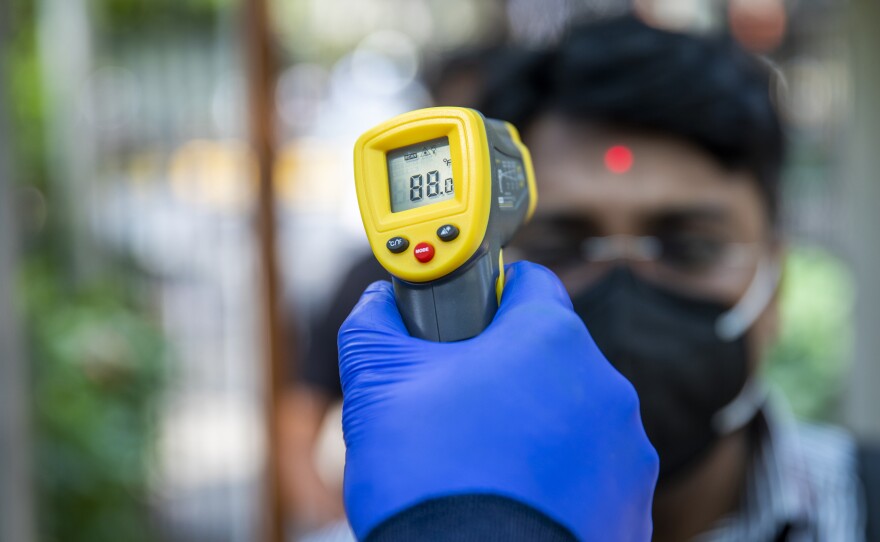Mild.
Moderate.
Serious.
Severe or extreme.
These are some of the adjectives being used to describe the symptoms displayed by patients with COVID-19. Vice President Pence used them in his remarks to the nation this week:
"Some — some large percentage have mild flu symptoms; some have serious flu symptoms."
At this stage of the COVID-19 pandemic, there is not a standard definition of what symptoms are associated with these designations.
It can take years for such guidelines to be issued for a newly identified disease, according to Dr. Sandro Galea, an epidemiologist and dean of the Boston University School of Public Health.
Nonetheless, there are some preliminary definitions that can be helpful in understanding the range of symptoms.
Mild
In 80% of known cases, COVID-19 causes mild to moderate illness, according to a report of a joint World Health Organization-China mission of 25 infectious disease experts held in China late last month.
At a press conference on March 9, Maria Van Kerkhove, technical lead of the WHO Health Emergencies Program, had this to say about the symptoms for a so-called "mild" case: "This mild infection starts normally with a fever, although it may take a couple of days to get a fever. You will have some respiratory symptoms; you have some aches and pains. You'll have a dry cough. This is what the majority of individuals will have."
It is "nothing that will make you feel like you need to run to a hospital," says Dr. Amesh Adalja, a senior scholar at the Johns Hopkins Center for Health Security.
A mild case of COVID-19 in and of itself is not dangerous. But in some cases — more commonly in older people and in people with underlying health issues — a mild case can progress to a moderate case that could require some supportive care such as fluids for dehydration, typically in an emergency room or urgent care center, especially if hospitals are overwhelmed by the most acute cases.
Moderate
Symptoms of being moderately ill with COVID-19 include coughing, fever above 100.4, chills and a feeling that you don't want to or can't get out of bed, says Adalja.
Some patients also experience shortness of breath, although that can occur in various ways. "Shortness of breath is a wide spectrum and whether we consider treatment will be based on how short of breath they are, their age and other health conditions," says Galea.
"Is it shortness of breath after climbing a flight of stairs or when there's no activity — for example, when you're just sitting in a chair?" says Dr. Theresa Madaline, hospital epidemiologist at the Montefiore Health System in New York City.
In either case, there's cause for concern with a confirmed or suspected COVID-19 case. "Shortness of breath [with this virus] is a symptom to always check with a health care provider. Period," says Dr. Kenneth E. Lyn-Kew, a pulmonologist in the Section of Critical Care Medicine and Department of Medicine at National Jewish Health in Denver.
That's because shortness of breath can be caused by low oxygen levels in the blood. Blood carries oxygen to organs and tissues, and low levels can lead to organ shutdown or even death.
For patients with moderate symptoms, hospitalization is unlikely unless they are having difficulty drawing a breath or are dehydrated. Signs of dehydration can include increased thirst, dry mouth, decreased urine output, yellow urine, dry skin, a headache and dizziness.
But there's another possible development within the "mild to moderate" classification. "Some of those individuals will go on to develop a mild form of pneumonia," Van Kerkhove says. While pneumonia can often resolve on its own, especially in younger people, in older people and in those with underlying health conditions, pneumonia can be life-threatening or require hospitalization, especially if their immune system is weak.
In these instances, without supplemental oxygen or, if needed, a respirator to aid breathing, a patient's organs can shut down and the patient can die, says Galea. People with pneumonia can also get secondary bacterial infections, which can be life-threatening and require treatment with intravenous antibiotics.
A case that is "mild to moderate" will last about two weeks from the first signs of symptoms to recovery, WHO says.
Serious, severe, extreme
According to the report of the WHO-China joint mission, in about 1 in 5 patients, the infection gets worse. About 14% of cases can develop into severe disease, where patients may need supplemental oxygen. And 6% of cases become critical and may experience septic shock — a significant drop in blood pressure that can lead to stroke, heart or respiratory failure, failure of other organs or death.
Theresa Madaline says that in some patients, symptoms can progress to severe in a few hours — or over several days.
A different problem can occur if disease progresses. The virus can enter lung cells and start replicating, killing the cells. The immune system may take action to fight the virus, creating inflammation, destroying lung tissue and sometimes resulting in a more severe form of pneumonia.
This [immune system] response can impair your ability to get oxygen into your blood. Without enough oxygen, inflammation can become more severe and result in organ failure.
What to tell your doctor about symptoms
"Keep in mind that mild, moderate and severe are the inelegant terms we have right now," says Dr. Shira Doron, hospital epidemiologist at Tufts Medical Center in Boston. "Use symptoms rather than adjectives when you speak to a health care provider" and then they can determine whether you need to consider treatment.
Copyright 2020 NPR. To see more, visit https://www.npr.org.






